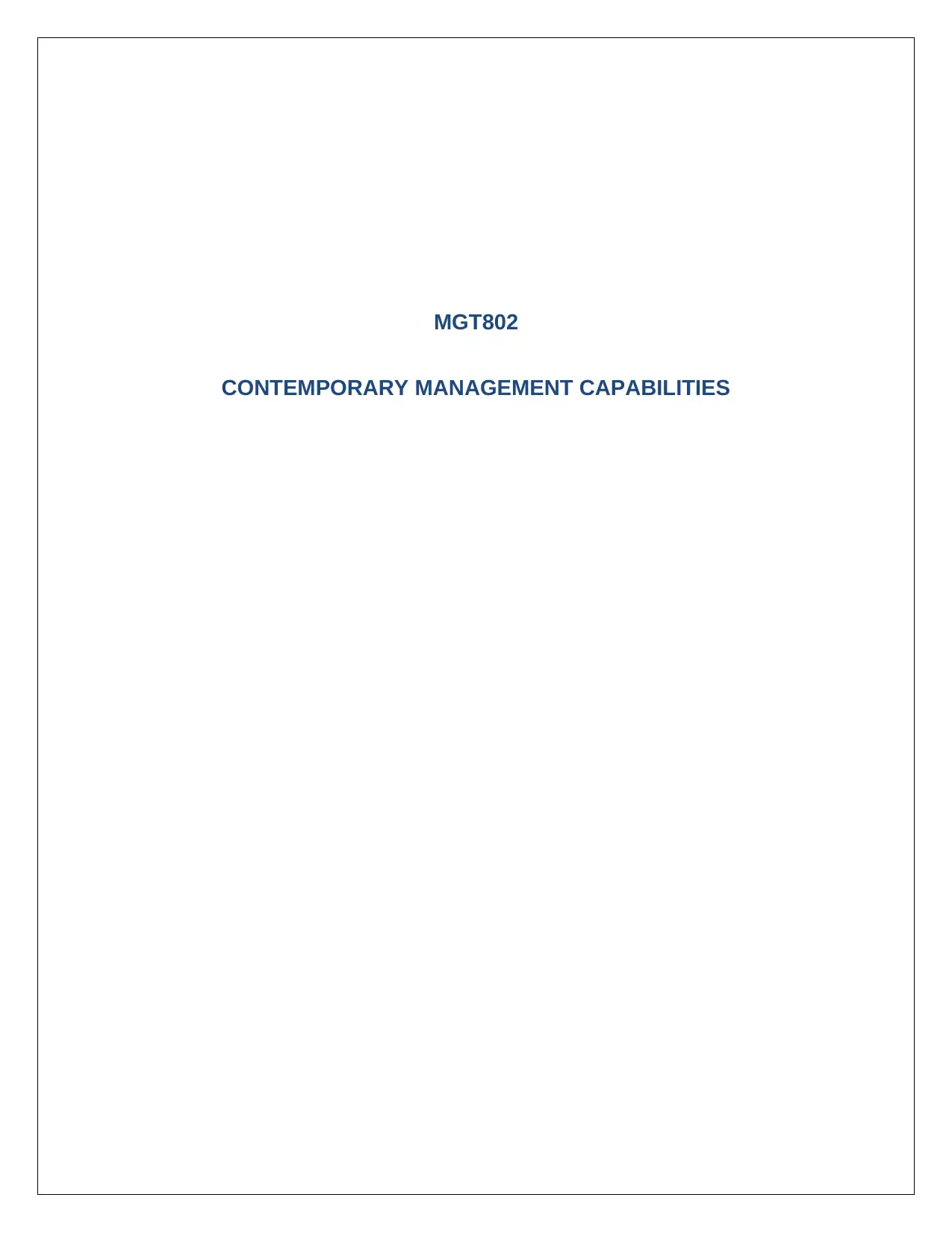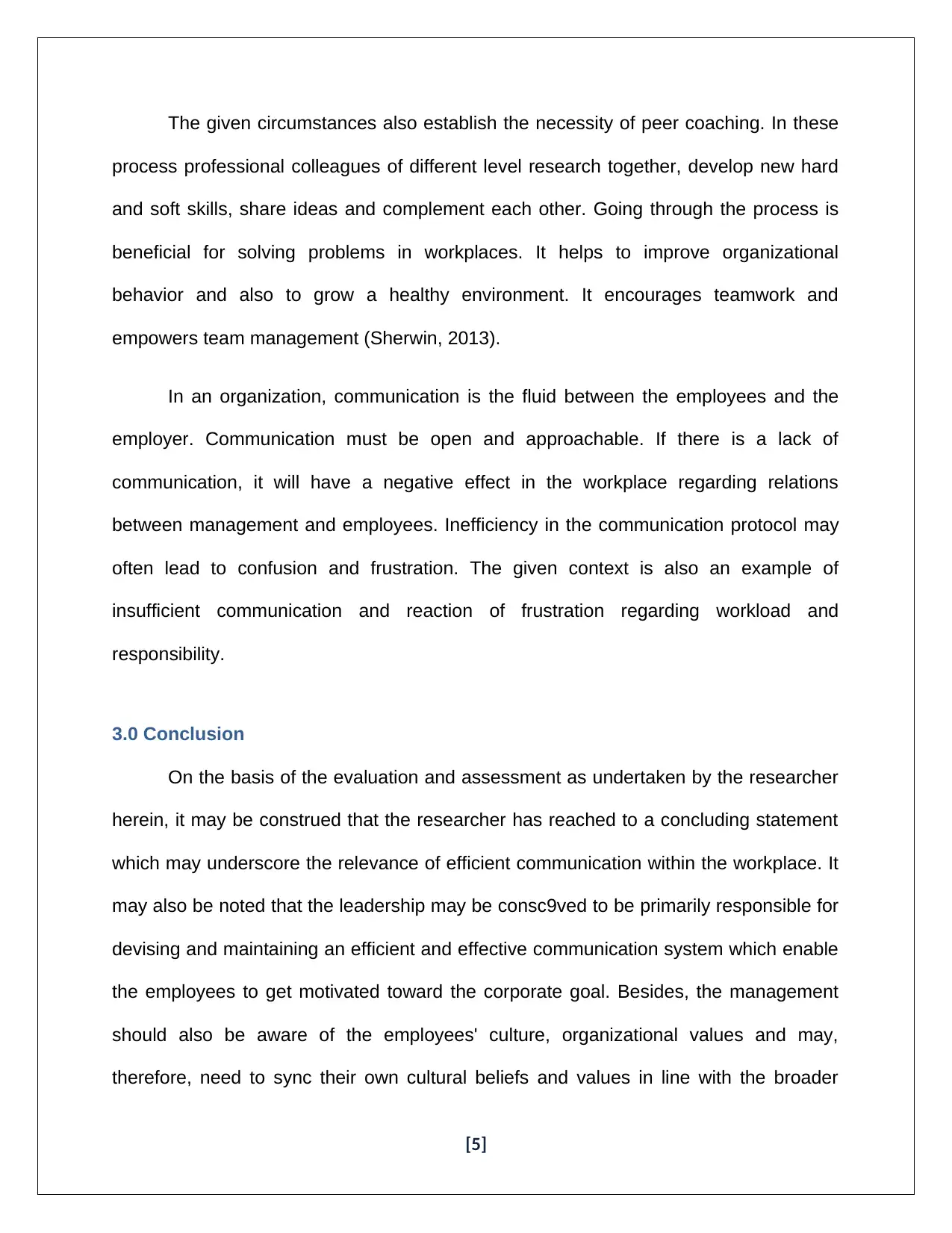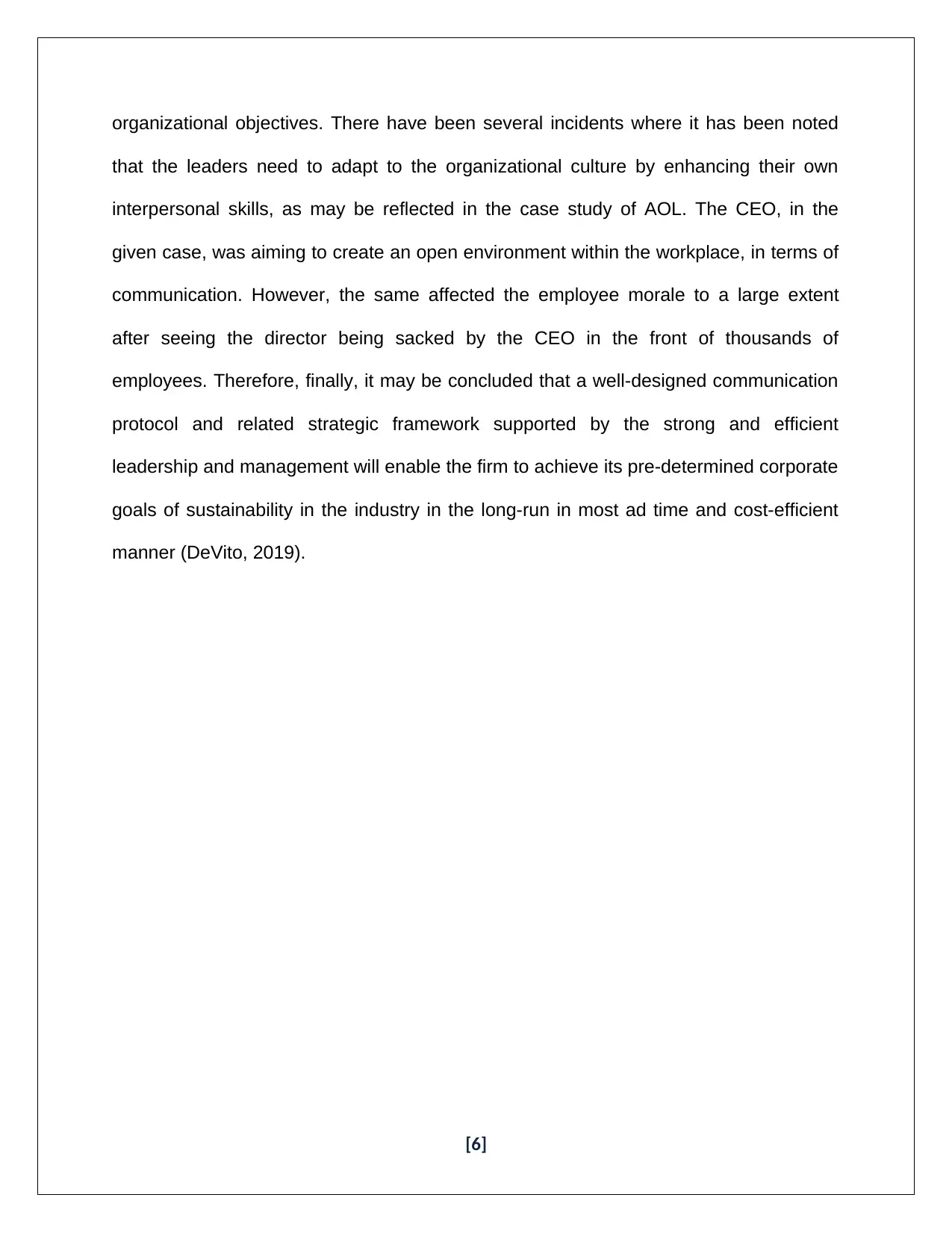MGT811: Peer Coaching Analysis and Plan for Contemporary Management
VerifiedAdded on 2023/03/17
|7
|1214
|52
Report
AI Summary
This report analyzes the importance of effective communication and peer coaching in contemporary management, using the case study of AOL's CEO firing an employee publicly. It explores the need for strong leadership skills, including self-reflection and emotional intelligence, to foster a positive work environment. The report emphasizes the significance of open communication channels and the development of both hard and soft skills for managers. It also discusses the benefits of peer coaching in problem-solving and team management. The conclusion stresses the importance of well-designed communication protocols and strategic frameworks, supported by strong leadership, to achieve organizational goals efficiently. The report provides a detailed analysis of the incident, and offers recommendations for improving communication and management capabilities within a business setting.

MGT802
CONTEMPORARY MANAGEMENT CAPABILITIES
CONTEMPORARY MANAGEMENT CAPABILITIES
Paraphrase This Document
Need a fresh take? Get an instant paraphrase of this document with our AI Paraphraser

Table of Contents
1.0 Introduction..................................................................................................................3
2.0 Contemporary Management Capabilities....................................................................4
3.0 Conclusion...................................................................................................................5
References.........................................................................................................................7
[2]
1.0 Introduction..................................................................................................................3
2.0 Contemporary Management Capabilities....................................................................4
3.0 Conclusion...................................................................................................................5
References.........................................................................................................................7
[2]

1.0 Introduction
The business organization is a coherent and systematic structure of different
elements and factors working together to achieve a pre-determined common goal. As a
result, the interrelation and interaction between various elements and factors are crucial
for the success of the business. In short, effective communication may be construed to
be an important and significant element on the part of the management in order to
ensure a smooth operation and sustainability of the business in the long-run (Ulmer,
Sellnow & Seeger, 2017). The present research work deals with the assessment of the
importance of communication in the context of a business organization. For the purpose
of the study, the real-world case study of AOL's CEO sacking one of its Directors
publicly in the year 21013 has been considered which is termed as a classic example of
poor business communication.
The researcher, in the very outset of the research study, lays down a succinct
introduction to the theme of the topic followed by the concise overview of the event that
took place in AOL. In the following segments of the given paper, the researcher
attempts to identify the various skills that the leadership should have in order to
maintain a strong communication system and an efficient organization culture within the
workplace. While discussing the same, the relevant theoretical framework has been
evaluated. Finally, the researcher concludes the assessment by way of providing a
recommendatory note in the end.
[3]
The business organization is a coherent and systematic structure of different
elements and factors working together to achieve a pre-determined common goal. As a
result, the interrelation and interaction between various elements and factors are crucial
for the success of the business. In short, effective communication may be construed to
be an important and significant element on the part of the management in order to
ensure a smooth operation and sustainability of the business in the long-run (Ulmer,
Sellnow & Seeger, 2017). The present research work deals with the assessment of the
importance of communication in the context of a business organization. For the purpose
of the study, the real-world case study of AOL's CEO sacking one of its Directors
publicly in the year 21013 has been considered which is termed as a classic example of
poor business communication.
The researcher, in the very outset of the research study, lays down a succinct
introduction to the theme of the topic followed by the concise overview of the event that
took place in AOL. In the following segments of the given paper, the researcher
attempts to identify the various skills that the leadership should have in order to
maintain a strong communication system and an efficient organization culture within the
workplace. While discussing the same, the relevant theoretical framework has been
evaluated. Finally, the researcher concludes the assessment by way of providing a
recommendatory note in the end.
[3]
⊘ This is a preview!⊘
Do you want full access?
Subscribe today to unlock all pages.

Trusted by 1+ million students worldwide

2.0 Contemporary Management Capabilities
In the given case study, it has been stated that AOL’s CEO Tim Armstrong fired
Patch creative director Abel Lenz publicly in August 2o13. Patch.com was AOL's local
newsgathering unit. Lenz was gathering information for AOL during a conference call.
The CEO could stop the call for a second and ask Lenz not to tap but Armstrong fired
Lenz brutally and then continued the call. It was just a 2 minute's conference. There
have been certain arguments against the behavior of the CEO which emphasizes on the
fact that the CEO may need counseling. However, Mr. Armstrong had realized his fault
a few days after the incident happened (Fiegerman, 2013). Finally, he apologized to
Lenz and to all the patch staffs as well but Lenz did not get his job back. A memo had
been issued to the staffs apologizing for the emotional outburst and also describing the
situation that Lenz was warned before sacking. The CEO had a fear of leaking
confidential information. This incident of firing a director in front of their colleagues was
criticized in all the countries (PETERSON, 2013).
In the above-discussed incident, the CEO was in a tough condition. He had done
a mistake under pressure. Armstrong could request Lenz to stop taking snaps and ask
him to have a talk after meeting. No doubt, the CEO had taken an impulsive decision
due to lack of communication. From the above discussion, it can also be noted that a
CEO must have some soft skills to handle all the awkward situations. He must practice
enhancing those skills through a thorough self-reflection which may act as a mirror in
which one can see his or her strength as well as weakness. It helps to understand one's
emotions and other driving factors. Self-reflection is asking some questions to oneself to
build emotional self-awareness.
[4]
In the given case study, it has been stated that AOL’s CEO Tim Armstrong fired
Patch creative director Abel Lenz publicly in August 2o13. Patch.com was AOL's local
newsgathering unit. Lenz was gathering information for AOL during a conference call.
The CEO could stop the call for a second and ask Lenz not to tap but Armstrong fired
Lenz brutally and then continued the call. It was just a 2 minute's conference. There
have been certain arguments against the behavior of the CEO which emphasizes on the
fact that the CEO may need counseling. However, Mr. Armstrong had realized his fault
a few days after the incident happened (Fiegerman, 2013). Finally, he apologized to
Lenz and to all the patch staffs as well but Lenz did not get his job back. A memo had
been issued to the staffs apologizing for the emotional outburst and also describing the
situation that Lenz was warned before sacking. The CEO had a fear of leaking
confidential information. This incident of firing a director in front of their colleagues was
criticized in all the countries (PETERSON, 2013).
In the above-discussed incident, the CEO was in a tough condition. He had done
a mistake under pressure. Armstrong could request Lenz to stop taking snaps and ask
him to have a talk after meeting. No doubt, the CEO had taken an impulsive decision
due to lack of communication. From the above discussion, it can also be noted that a
CEO must have some soft skills to handle all the awkward situations. He must practice
enhancing those skills through a thorough self-reflection which may act as a mirror in
which one can see his or her strength as well as weakness. It helps to understand one's
emotions and other driving factors. Self-reflection is asking some questions to oneself to
build emotional self-awareness.
[4]
Paraphrase This Document
Need a fresh take? Get an instant paraphrase of this document with our AI Paraphraser

The given circumstances also establish the necessity of peer coaching. In these
process professional colleagues of different level research together, develop new hard
and soft skills, share ideas and complement each other. Going through the process is
beneficial for solving problems in workplaces. It helps to improve organizational
behavior and also to grow a healthy environment. It encourages teamwork and
empowers team management (Sherwin, 2013).
In an organization, communication is the fluid between the employees and the
employer. Communication must be open and approachable. If there is a lack of
communication, it will have a negative effect in the workplace regarding relations
between management and employees. Inefficiency in the communication protocol may
often lead to confusion and frustration. The given context is also an example of
insufficient communication and reaction of frustration regarding workload and
responsibility.
3.0 Conclusion
On the basis of the evaluation and assessment as undertaken by the researcher
herein, it may be construed that the researcher has reached to a concluding statement
which may underscore the relevance of efficient communication within the workplace. It
may also be noted that the leadership may be consc9ved to be primarily responsible for
devising and maintaining an efficient and effective communication system which enable
the employees to get motivated toward the corporate goal. Besides, the management
should also be aware of the employees' culture, organizational values and may,
therefore, need to sync their own cultural beliefs and values in line with the broader
[5]
process professional colleagues of different level research together, develop new hard
and soft skills, share ideas and complement each other. Going through the process is
beneficial for solving problems in workplaces. It helps to improve organizational
behavior and also to grow a healthy environment. It encourages teamwork and
empowers team management (Sherwin, 2013).
In an organization, communication is the fluid between the employees and the
employer. Communication must be open and approachable. If there is a lack of
communication, it will have a negative effect in the workplace regarding relations
between management and employees. Inefficiency in the communication protocol may
often lead to confusion and frustration. The given context is also an example of
insufficient communication and reaction of frustration regarding workload and
responsibility.
3.0 Conclusion
On the basis of the evaluation and assessment as undertaken by the researcher
herein, it may be construed that the researcher has reached to a concluding statement
which may underscore the relevance of efficient communication within the workplace. It
may also be noted that the leadership may be consc9ved to be primarily responsible for
devising and maintaining an efficient and effective communication system which enable
the employees to get motivated toward the corporate goal. Besides, the management
should also be aware of the employees' culture, organizational values and may,
therefore, need to sync their own cultural beliefs and values in line with the broader
[5]

organizational objectives. There have been several incidents where it has been noted
that the leaders need to adapt to the organizational culture by enhancing their own
interpersonal skills, as may be reflected in the case study of AOL. The CEO, in the
given case, was aiming to create an open environment within the workplace, in terms of
communication. However, the same affected the employee morale to a large extent
after seeing the director being sacked by the CEO in the front of thousands of
employees. Therefore, finally, it may be concluded that a well-designed communication
protocol and related strategic framework supported by the strong and efficient
leadership and management will enable the firm to achieve its pre-determined corporate
goals of sustainability in the industry in the long-run in most ad time and cost-efficient
manner (DeVito, 2019).
[6]
that the leaders need to adapt to the organizational culture by enhancing their own
interpersonal skills, as may be reflected in the case study of AOL. The CEO, in the
given case, was aiming to create an open environment within the workplace, in terms of
communication. However, the same affected the employee morale to a large extent
after seeing the director being sacked by the CEO in the front of thousands of
employees. Therefore, finally, it may be concluded that a well-designed communication
protocol and related strategic framework supported by the strong and efficient
leadership and management will enable the firm to achieve its pre-determined corporate
goals of sustainability in the industry in the long-run in most ad time and cost-efficient
manner (DeVito, 2019).
[6]
⊘ This is a preview!⊘
Do you want full access?
Subscribe today to unlock all pages.

Trusted by 1+ million students worldwide

References
DeVito, J. A. (2019). The interpersonal communication book. Instructor, 1, 18.
Fiegerman, S. (2013). AOL CEO Apologizes for Firing Patch Exec in Front of Hundreds
of Employees. Retrieved from https://mashable.com/2013/08/13/tim-armstrong-
apologizes/
PETERSON, H. (2013). These photos got a man fired: AOL employee’s snaps of Tim
Armstrong revealed as boss apologizes for ‘emotional’ outburst in which he
sacked creative director mid meeting. Retrieved from
https://www.dailymail.co.uk/news/article-2392815/AOL-CEO-Tim-Armstrong-
apologizes-staff-publicly-firing-creative-director-Abel-Lenz.html
Sherwin, A. (2013). AOL boss Tim Armstrong apologises for firing employee during.
Retrieved from https://www.independent.co.uk/news/world/americas/aol-boss-
tim-armstrong-apologises-for-firing-employee-during-conference-call-with-1000-
staff-at-8761824.html
Ulmer, R. R., Sellnow, T. L., & Seeger, M. W. (2017). Effective crisis communication:
Moving from crisis to opportunity. Sage Publications.
[7]
DeVito, J. A. (2019). The interpersonal communication book. Instructor, 1, 18.
Fiegerman, S. (2013). AOL CEO Apologizes for Firing Patch Exec in Front of Hundreds
of Employees. Retrieved from https://mashable.com/2013/08/13/tim-armstrong-
apologizes/
PETERSON, H. (2013). These photos got a man fired: AOL employee’s snaps of Tim
Armstrong revealed as boss apologizes for ‘emotional’ outburst in which he
sacked creative director mid meeting. Retrieved from
https://www.dailymail.co.uk/news/article-2392815/AOL-CEO-Tim-Armstrong-
apologizes-staff-publicly-firing-creative-director-Abel-Lenz.html
Sherwin, A. (2013). AOL boss Tim Armstrong apologises for firing employee during.
Retrieved from https://www.independent.co.uk/news/world/americas/aol-boss-
tim-armstrong-apologises-for-firing-employee-during-conference-call-with-1000-
staff-at-8761824.html
Ulmer, R. R., Sellnow, T. L., & Seeger, M. W. (2017). Effective crisis communication:
Moving from crisis to opportunity. Sage Publications.
[7]
1 out of 7
Your All-in-One AI-Powered Toolkit for Academic Success.
+13062052269
info@desklib.com
Available 24*7 on WhatsApp / Email
![[object Object]](/_next/static/media/star-bottom.7253800d.svg)
Unlock your academic potential
Copyright © 2020–2025 A2Z Services. All Rights Reserved. Developed and managed by ZUCOL.

